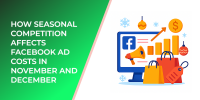Seasonal shifts dramatically influence how people browse, shop, and engage with ads. During certain times of the year—holidays, back‑to‑school, travel seasons, or industry‑specific peaks—audiences behave differently. They interact with content at different times, prioritize new needs, and respond more actively to specific messaging. Effective advertisers track these patterns and adjust their targeting to stay aligned with real‑time behavior.
This ensures ad spend is allocated efficiently, avoids wasted impressions, and improves conversion rates when demand is at its highest.
Why Seasonal Audience Shifts Matter
Seasonality is one of the strongest drivers of changes in online behavior. Data consistently shows:
-
Over 40% of annual retail sales occur in Q4 due to holiday demand surges.
-
Search interest for gift‑related products increases by more than 60% each November and December.
-
Customer acquisition costs can rise by 20–30% during peak seasons if targeting is not adjusted.

Seasonal campaign alignment can boost conversion rates by about 20%
These fluctuations mean the audience that converts strongly in one season may behave differently—or be replaced by newly active segments—in another.
Key Seasonal Changes to Track
1. Shifts in Buyer Intent
During peak seasons, more high‑intent visitors flood digital platforms. These users often convert faster, but competition for their attention increases.
2. Changes in Interests and Motivations
Seasonal priorities shift: summer travel, winter holidays, new‑year self‑improvement, or back‑to‑school planning. Targeting must follow these evolving motivations.
3. Engagement Time Patterns
People browse more during evenings in winter and more during daytime in summer. Adjusting delivery timing ensures ads reach users when they are most active.
How to Adjust Your Targeting Strategy
1. Use Seasonal Data to Update Custom Audiences
Review which audience segments performed best during the same season last year. Add fresh high‑intent users entering the category and exclude segments that show declining engagement.
2. Increase Frequency for High‑Intent Periods
During peak buying windows, consider raising frequency caps. With purchase urgency higher, repeated messaging often leads to faster conversions.
3. Refresh Creative and Messaging to Match the Moment
Seasonal relevance boosts performance. Tailor your visuals and copy to reflect seasonal needs and motivations.
4. Monitor Real‑Time Behavior Shifts
Track engagement rates, click‑through rates, and conversion patterns daily. Even small adjustments to targeting parameters during seasonal peaks can lead to meaningful performance improvements.
5. Reallocate Budget Toward Seasonal Hot Segments
Shift more budget to the audiences that historically convert during the current season. Reinforce re‑engagement for returning visitors, especially during high‑intent periods.
Useful Statistics to Guide Seasonal Targeting
-
Over 70% of consumers say seasonal promotions influence their purchasing decisions.
-
Retargeted holiday shoppers have conversion rates up to 30% higher compared to non‑seasonal periods.
-
Seasonal shoppers revisit websites 2–3 times more often before purchasing.

Peak seasonal revenue can account for nearly a third of a retailer’s annual total
These benchmarks help determine when to tighten targeting, when to expand reach, and when to increase frequency.
Recommended Next Articles
Conclusion
Seasonal audience shifts are predictable but require active monitoring and fast adaptation. By identifying intent changes, aligning messaging with seasonal motivations, and adjusting audience segments at the right time, brands maintain relevance and maximize conversion potential throughout the year.

